Complete Solutions to Short Answer Questions of chapter OSCILLATIONS AND WAVES of Class 11 book with complete answers and questions
| Class 11 | PHYSICS |
| Chapter | OSCILLATIONS AND WAVES |
| PRADEEP | Short Answer Questions |
| Number Of Questions | 100 |
| Academic Year | 2023-24 |
Are the functions `tanomegat ` and `cotomegat`
(i) periodic and (ii) harmonic. Explain.
View SolutionThe amplitude of a simple harmonic oscillation is doubled. How does this affect
(i) periodic time (ii) maximum velocity (iii) maximum acceleration and
(iv) maximum energy
View SolutionWhat would happen to the motion of an oscillating system if the sign of the force term in equation `F=-kx` is changed?
View SolutionWhich of the following funchtions of time represent (a) periodic and (b) non-periodic motion? Give the period for each of period motion. `(omega` is any positive constant )
(i) `sinomegat+cosomegat`
(ii) `sinomegat+cos2omegat+sin4omegat`
(iii) `e^(-omegat)` (iv) `logomegat`
View SolutionWhich of the following functions of time represent (a) simple harmonic motion and (b) periodic but not simple harmonic motion? Give the period for each case.
(i)` sinomegat-cosomegat` (ii) `sin^(2)omegat` (iii) `cosomegat+2sin^(2)omegat`
View SolutionThe relation between the acceleration a and displacement x of a particle executing SHM is `a=-(p//q)y` , where p and q are constant quantities. What will be the time period of oscillation of the particle ? If p is doubled and q is halved, then find the value of new time period of oscillation.
View SolutionDoes the function `y=cos^(2)omegat ` represent a periodic of a simple harmonic motion? What is the period of the motion?
View SolutionThe displacement of a harmoniv oscillatore is given by `x=alphasinomegat+betacosomegat.` What is the amplitude of the oscillation?
View SolutionA particle moves according to the law, `x=acos(pit//2).` . What is the distance covered by it in time interval `t=0` to `t=3` second.
View SolutionA block rests on a horizontal table which is executing SHM in the horizontal plane with an amplitude A. What will be the frequency of oscillation, the block will just start to slip? Coefficient of friction`=mu`.
View SolutionAt what displacement (i) the P.E. of a simple harmonic oscillator is maximum and minum (ii) the K.E. is maximum and minmum?
View SolutionThe angular velocity and amplitude of simple pendulum are `omega` and r respectively. At a displacement x from the mean position, if its kinetice energy is T and potential energy is U, find the ration of T to U.
View SolutionThe amplitude of a simiple harmonic oscillator is tripled. How does this affect (i) the maximum velocity (ii) the total energy and (iii) the period of the oscillator?
View SolutionTha particle is executing SHM. The amplitude of motion is a. State those positions of the particle in terms of a when (i) the K.E. of the particle is zero (ii) P.E. is zero (iii) P.E. is one-fourth of the total energy (iv) P.E and K.E. are equal.
View SolutionA mass (M) is suspended from a spring of negligible mass. The spring is pulled a little and then released so that the mass executes SHM of time period T. If the mass is increased by m, the time period becomes `(5T)/3`. Then the ratio of `m/M` is .
View SolutionYou have a light spring, a metre scale and a known mass. How will you find the time period of oscillation of mass without the use of a clock ?
View SolutionA simple pendulum is hung in a stationary lift and its periodic time is T. What will be the effect on its periodic time T if
(i) the lift is moving up with a uniform velocity v,
(ii) the lift is moving up with a uniform acceleration a, and (iii) the lift is moving down with a uniform acceleration a?
View SolutionThe length of a simple pendulum executing simple harmonic motion is increased by `21%`. The percentage increase in the time period of the pendulum of increased lingth is.
View SolutionThe bob of a vibrating simple pendulum is made of ice. How will the period of swing will change when the ice starts melting?
View SolutionThe bob of a simple pendulumis a ball full of water. If a fine hole is made in the bottom of the ball, what will be its effect on the time period of the pendulum?
View SolutionA mass m is dropped in a tunnel along the diameter of earth from a height `h(ltlt R)` above the surface of earth. Find the time period of motion. Is the motion simple harmonic?
View SolutionA pendulum clock is placed on the moon, where object weighs only one-sixth as much as on earth. How many times the clock tick out in an actual time of 1 minute, the clock keeps good time on earth.
View SolutionA ball of radius r is made to oscillate in a bowl of radius R, find its time period of oscillation.
View SolutionWhat is the length of a simple pendulum which ticks second?
View SolutionWhat will happen to the motion of simple pendulum if the amplitude of motion is large? How does period of oscillation change with amplitude?
View SolutionDefine force constant of a sring. Give its SI unit and dimensional formula.
View Solutionfour different springs arrangements. If the mass m in each arrangement is displaced from its equilibrium position and released, what is the resulting frequency of vibration ini each case? Neglect the mass of the spring. Figure (a) and (b) represent an arrangement of springs in parallel and (c) and (d) represent springs in series?

View SolutionTwo identical springs have the same force constant of `147Nm^(-1)`. What elongation will be produced in each spring in each case shown in figure? `g=9.8ms^(-2)`.
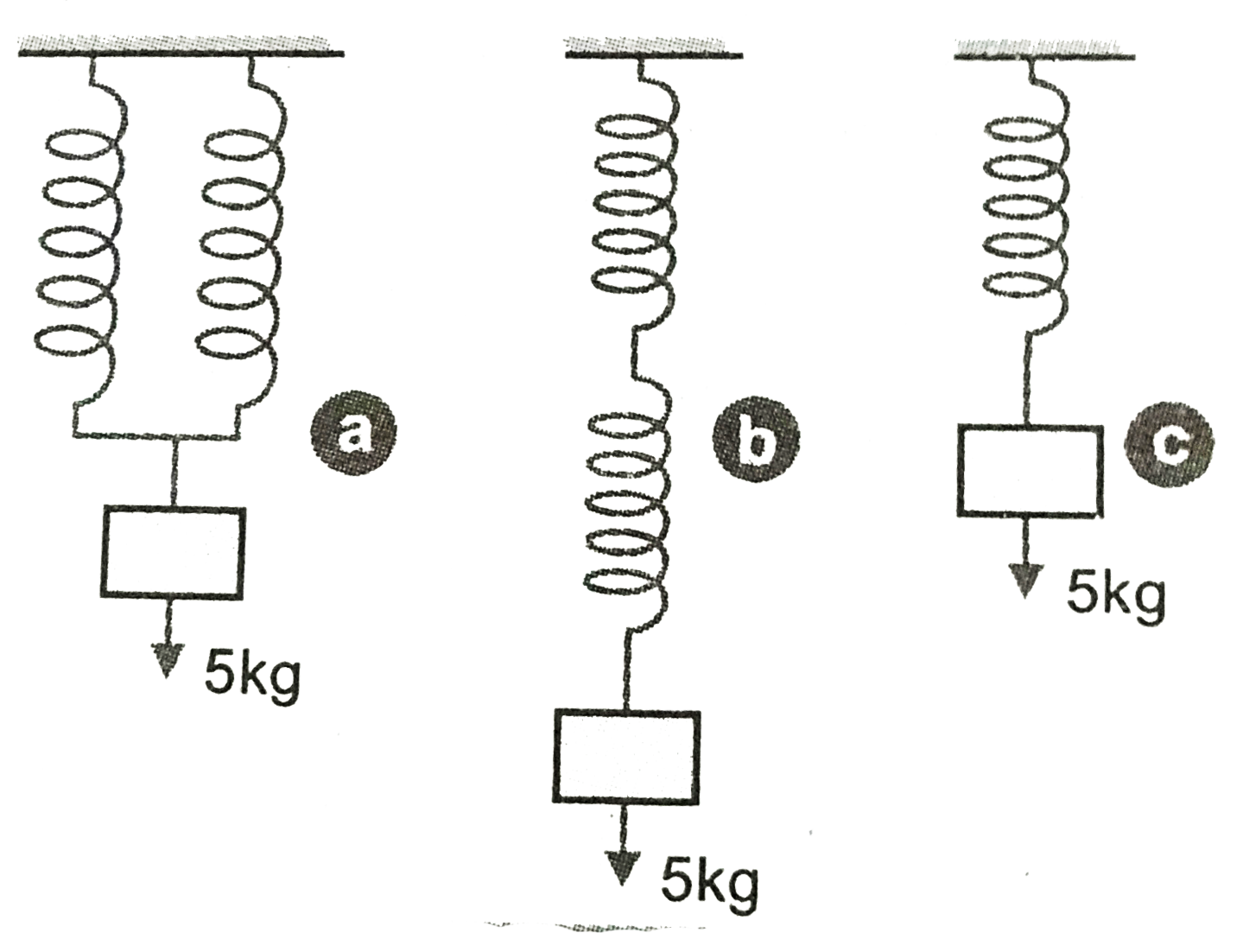
View SolutionThe frequency of oscillation of a mass m suspended by a spring is `v_(1)`. If the length of the spring is cut to on-half, the same mass oscillates with frequency `v_(2)`. Determing the value of `v_(2)//v_(1)`.
View SolutionThe periodic time of a mass suspended by a spring (force constant K) is T. If the spring is cut in three equal pieces, what will be the force constant of each part? If the same mass be suspended from one piece, what will be the periodic time?
View SolutionThree springs are connected to a mass m as shown in figure, When mass oscillates, what is the effective spring constant and time period of vibration? Given `k=2Nm^(-1)` and m=80 gram.
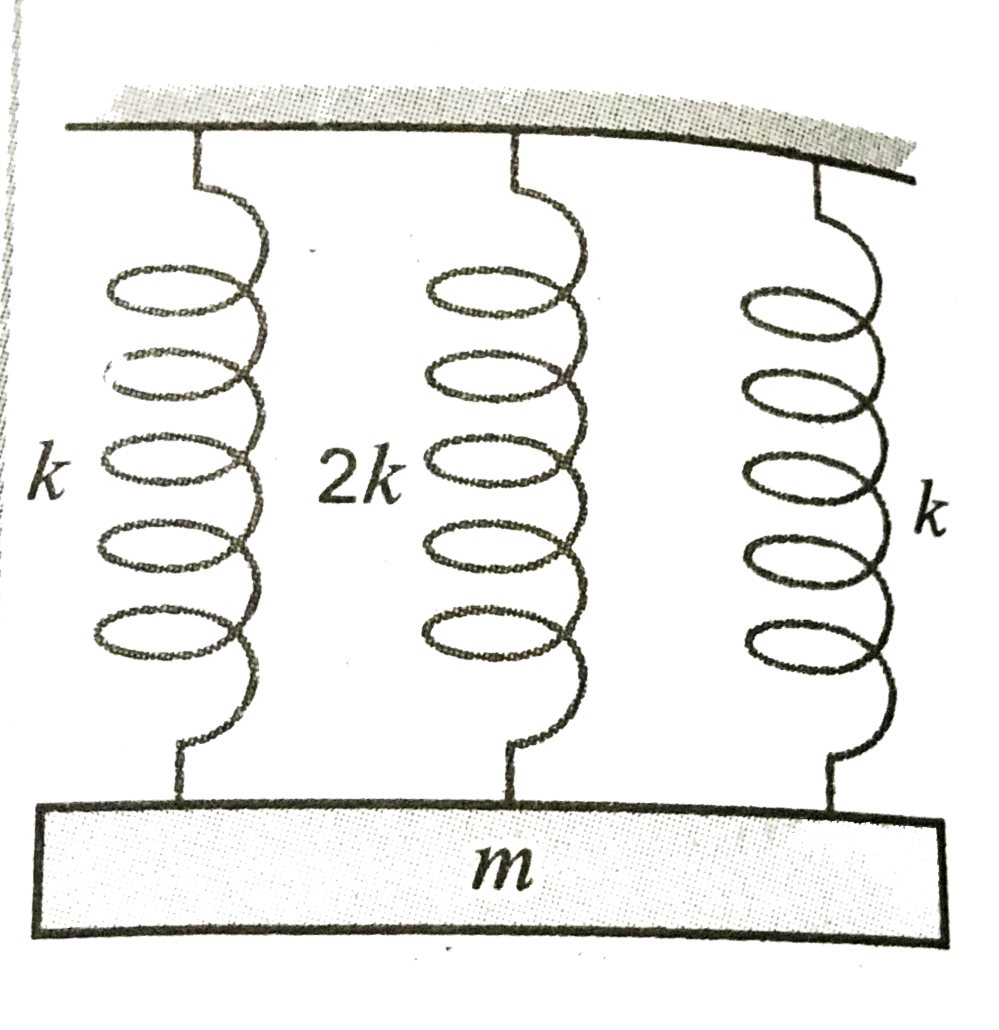
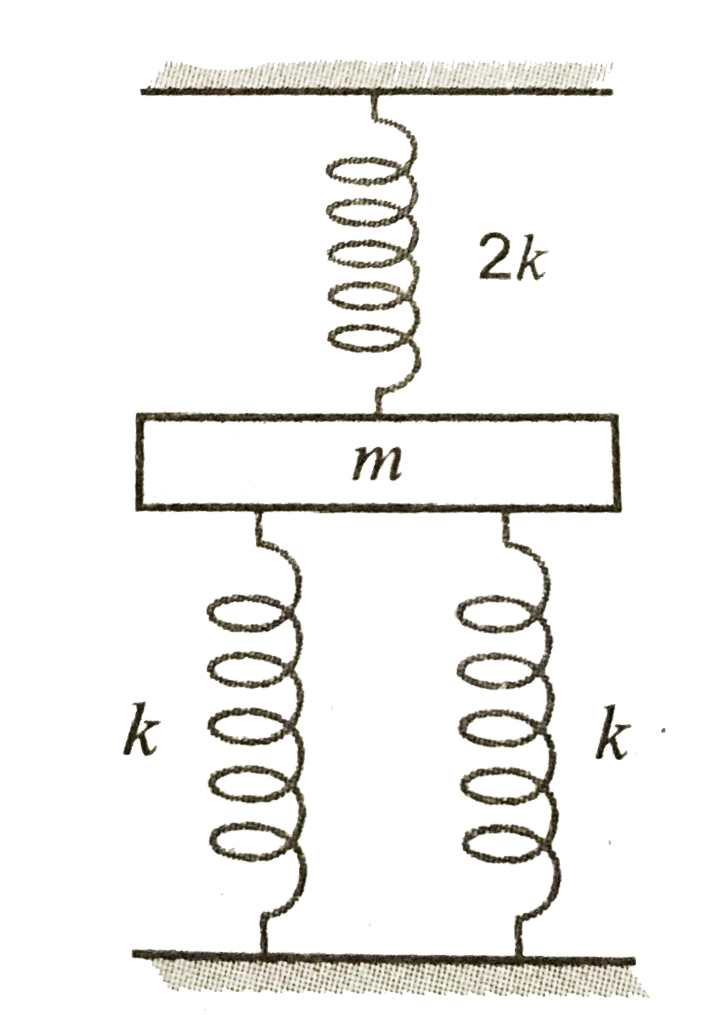
View SolutionAmplitude of a wave is represented by `A=(c)/(a+b-c)`. Under what conditions, the resonance will occur.
View SolutionExplain periodic motion and oscillatory motion with illustrations.
View SolutionDistinguish clearly Harmonic and Non-Harmonic ocsillations.
View SolutionWhat do you understand by SHM? Explain its geometrical interpretation.
View SolutionDerive ann expression for the time period of a SHM in terms of inertia factor and spring factor.
View SolutionWhat is a simple pendulum? Find an expression for the time period and frequency of a simple pendulum.
View SolutionA cylindrical piece of cork of base area A and height h floats in a liquid of density `rho_(1)`. The cork is depressed slightly and then released. Show that the cork oscillates up and down simple harmonically with a period
`T=2pisqrt((hrho)/(rho_(1)g))`
View SolutionExplain the oscillations of a loaded spring and find the realtions for the time period and frequency in case of (i) horizontal spring (ii) vertical spring.
View SolutionWhat is a spring factor? Find its value in case of two springs connected in (i) series and (ii) parallel.
View SolutionDistinguish clearly with an illustration between free, forced and resonant oscillations.
View SolutionA wave transmits linear momentum. Can it transfer angular momentum?
View SolutionWhat is a non dispersive medium?
View SolutionCan transverse waves be produced in air ?
View SolutionWaves are generated on a water surface. Calculated the phase difference between two points A and B, when
(i) A and B lie on the same wave front at a distance `=2lambda` between them.
(ii) A and B lie on successive crests separated by 1 metre.
(iii) A and B lie on successive troughs separated by 1.5m
View SolutionGiven below are some eamples of wave motion. State in each case, if the wave motino is transverse, longitudinal or a combination of both?
(i) Motion of a kink in a long coil spring produced by displacing one end of spring side ways.
(ii) Waves produed in a cylinder containing a liquid by moving its piston back and forth.
(iii) Waves produed by a motor boat sailing in water.
(iv) Light waves travelling from sun to earth.
(v) ultrasonic waves in air produced by a vibrating quartz crystal.
View SolutionThe speed of sound waves depends on temperature but speed of ligth waves does not. Why?
View SolutionDistinguish between sound waves and radio waves of same frequency, say 15kHz.
View SolutionAir gets thinner as we go up in the atmosphere. Will the velocity of sound change?
View SolutionA person deep inside water cannot hear sound produced in air. Why?
View SolutionA student plotted the following four graphs representing the variation of velocity of sound in a gas with the pressure P. Which one is correct?
View SolutionSet up a relation between speed of sound in a gas and root mean sqare velocity of the molecules of that gas.
View SolutionWhy does sound travel faster in solids that in gases?
View SolutionAt a constant temperature, pressure of a gas is made 4 times. How is velocity of sound in the medium affected ?
View SolutionWhat will be the speed of sound in a perfectly rigid rod?
View SolutionDoes the sound of a bomb explosion travel faster than the sound of a humming bee?
View SolutionUnder what condition does a sudden phase reversal of waves occur on reflection?
View SolutionExplain why waves on strings are always transverse?
View SolutionHow will the fundamental frequency of a closed organ pipe be affected if instead of air, it is filled with a gas heavier than air?
View SolutionWhen an air column at `27^(@)C` and a tuning fork are sounded together, 5 beats per second are produced. The frequency of the fork is less than that of air column. No beat is heard at `-3^(@)C`. Determine the frequency of the fork.
View SolutionA column of air at `51^(@) C` and a tuning fork produce `4` beats per second when sounded together. As the temperature of the air column is decreased, the number of beats per second tends to decrease and when the temperature is `16^(@) C` the two produce `1` beat per second. Find the frequency of the tuning fork.
View SolutionDuring earthquake, both longifudinal and transverse waves are produced having speeds `4.0km//s` and `8.0km//s` respectively. If the first transverse wave reahes the seismograph 8 miniutes after the arrival of first longitudinal wave, then find the distance of the position, where the earthquake occured.
View SolutionA light pointer fixed to one prong of a tuning fork touches gnetly a smoked vertical plate. The fork is set vibrating and the plate is allowed to fall freely. 8 complete oscilllations are counted when the plate falls through 10cm.What is the frequency of the tuning fork?
View SolutionTwo identical sinusoidal waves, moving in same direction along a stretched string, interfere, with each other. The amplitude of each wave is 10.0mm, and the phase difference between them is `80^(@)`. What is the amplitude of the resultant wave and the nature of interference ?
View SolutionTwo sound waves, originating from the same source, travel aong difeent paths in air and then meet at a point. If the source vibrates at a frequency of 1.0 kHz and one path is 83 cm longer than the other, what iwill be theture of iterference? The speed of soundin air is `ms^-1`.
View SolutionHow does the frequency of a vibrating wire change when the attached load is immersed in water.
View SolutionDoes the frequency of a vibrating tuning fork change on increasing the temperature?
View SolutionAn organ pipe emits a fundamental note of 100Hz. On blowing into it more strongly, the note produced has frequency 300Hz. Is the pipe open or closed?
View SolutionTwo progressive sound waves each of frequency 170Hz and travelling in opposite directions in air superpose to produce stationary waves.
The speed of sound in air is 340 m`//`s. What is the
(i) separation between two successive nodes?
(ii) separation between two successive antinodes?
(iii) separation between a node and nearest antinode?
View SolutionThere are two wires, each produces frequency of 500Hz. By what percentage tension in one wire is increased so that 5 beats per second can be heard?
View SolutionWhat would a person hear, if he moves away from a source of sound with the speed of sound?
View SolutionCan beats be observed in two light sources of nearly equal frequencies ?
View SolutionIs it necessary for production of beats that the two waves must have exactly equal amplitudes?
View SolutionTwo sources of sound having frequencies 450Hz and 400Hz are sounded together. Will beats be produced. Can they be heard?
View SolutionIs Doppler effect applicablel only to sound waves.
View SolutionWhat physical change occurs when a source of sound moves and listener is at rest?
View SolutionWhat physical change occurs when source of sound waves is at rest and the listener moves?
View SolutionA person riding on a merry go round emits a sound wave of a certain frequency Does a person at the centre observe the Doppler effect?
View SolutionWill there be any Doppler whift when source and listener move in the same direction with the same velocity /
View SolutionA sitar wire and a tabla, when sounded together, produce 5 beats per second. What does it indicate ? If the tabla membrane is tightened, will the beat rate increase or decrease ?
View SolutionWhat is wave function ? Give general form of wave function. What is a periodic function?
View SolutionBriefly discuss how phase of a wave motion changes with position and time ?
View SolutionWhy should two sources of sound have nearly equal frequencies for the formation of beats?
View SolutionWhy does a dispersive medium distort a wave pulse?
View SolutionWhich factors determine the frequency of a tuning fork ?
View SolutionDistinguish between harmonics and overtones.
View SolutionFind the time period of mass M when displaced from its equilibrium position and then reelased for the system shown in figure.

View SolutionShow that the motino of a particle represented by `y=sinomegat-cosomegat` is simple harmonic with a period of `2pi//omega`.
View SolutionFind the displacement of a simple harmonic oscillator at which its P.E. is half of the maximum energy of the oscillator.
View SolutionA body of mass m is situated in a potential field `U(x)=U_(0)(1-cosalphax)` when `U_(0)` and `alpha` are constant. Find the time period of small oscialltions.
View SolutionA mass of 2 kg is attached to the spring constant `50Nm^(-1)`. The block is pulled to a distance of 5cm from its equilibrium position at `x=0` on a horizontal frictionless surface from rest at `t=0`. Write the expression for its displacement at anytime t.
View SolutionConsider a pair of identical pendulums, which oscillate with equal amplitude independently such that when one pendulum is at its extreme position making an angle os `2^(@)` to the right with the vertical , the other pendulum makes an angle of `1^(@)` to the left of the vertical. What is the phase difference between the pendulums?
View SolutionA steel wire has a length of 12.0m and a mass of 2.10kg. What should be the tension in the wire so that speed of a transverse wave on the wire equals the speed of sound in dry air at `20^(@)C=343ms^(-1)`.
View SolutionA pipe 20 cm long is closed at one end. Which harmonic mode of the pipe is resonantly excited by a source of 1237.5 Hz ? (sound velocity in air `=30ms^(-1))`
View SolutionA train standing at the outer signal of a railway station blows a whistle of frequency 400Hz in still air. The train begins to move with a speed of `10ms^(-1)` towards the platform. What is the frequency of the sound for an observer standing on the platform ? (sound velocity in air `=330ms^(-1))`
View SolutionThe wave pattern on a stretched string is shown in figure. Interpret what kind of wave this is and find its wavelength.
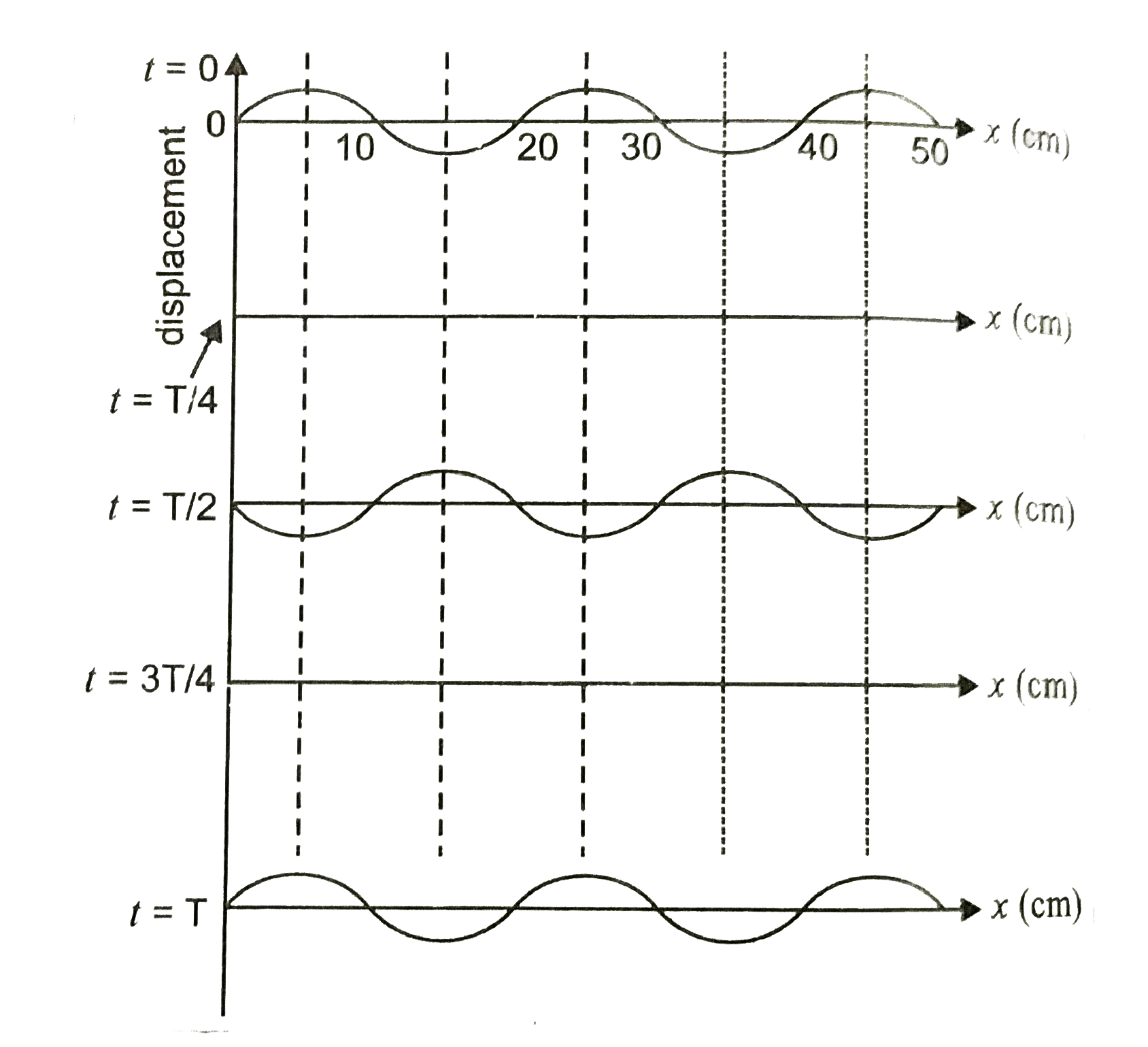
View SolutionThe pattern of standing waves formed on a stretched strinig at two instants of time are shown in figure. The velocity of two waves superimposing to form stationary wave is `360ms^(-1)` and their frequencies are 256 Hz.
(a) Calculate the time at which the second curve is plotted. ltbr. (b) Mark nodes and antinodes on the curve.
(c) Calculate the distance between `A^(')` and `C^(')`.
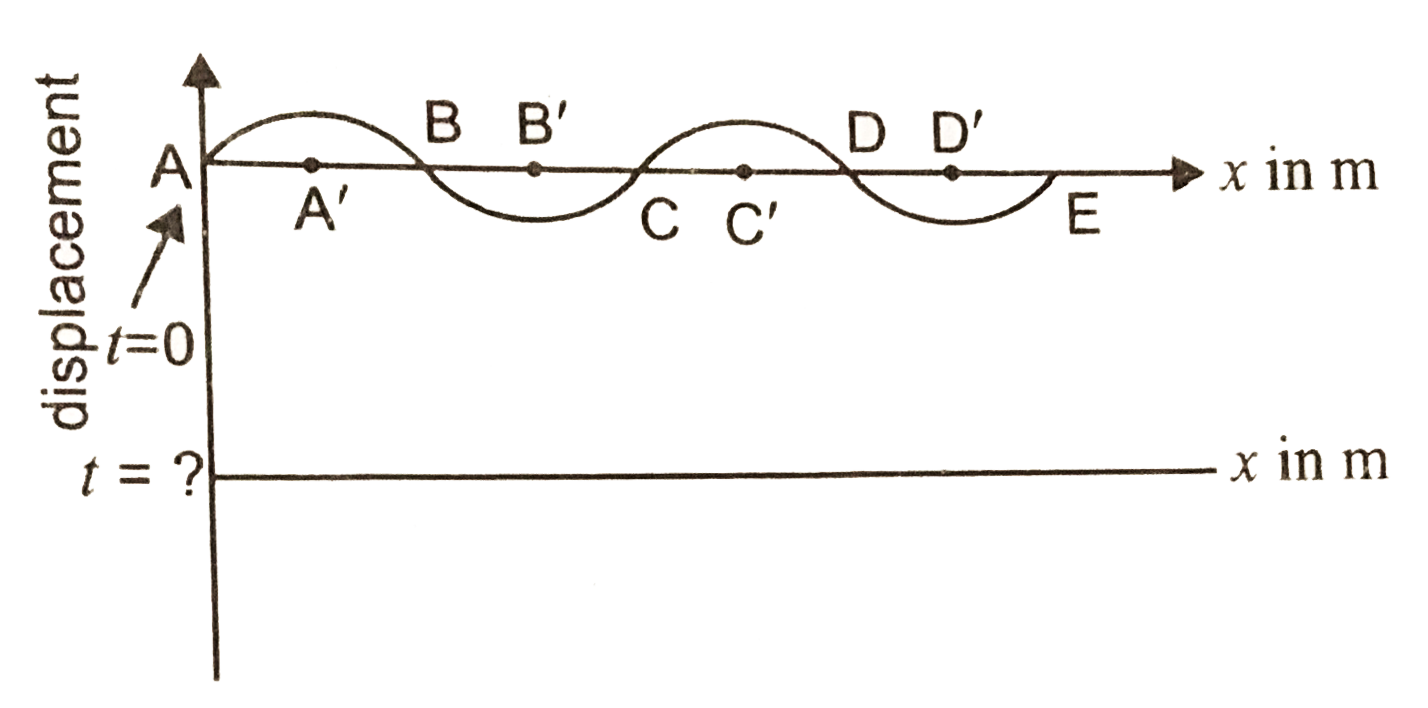
View SolutionA tuning fork vibrating with a frequency of 512 Hz is kept close to the open end of a tube filled with water , figure. The water level in the tube is gradually lowerd. When the water level is 17cm below the open end, maximum intensity of sound in heard. If the room temperature is `20^(@)C`, calculate
(a) speed of sound in air at room temperature.
(b) speed of sound in air at `0^(@)C`
(c) if the water in the tube is replaced with mercury, will there be any difference in your observations?
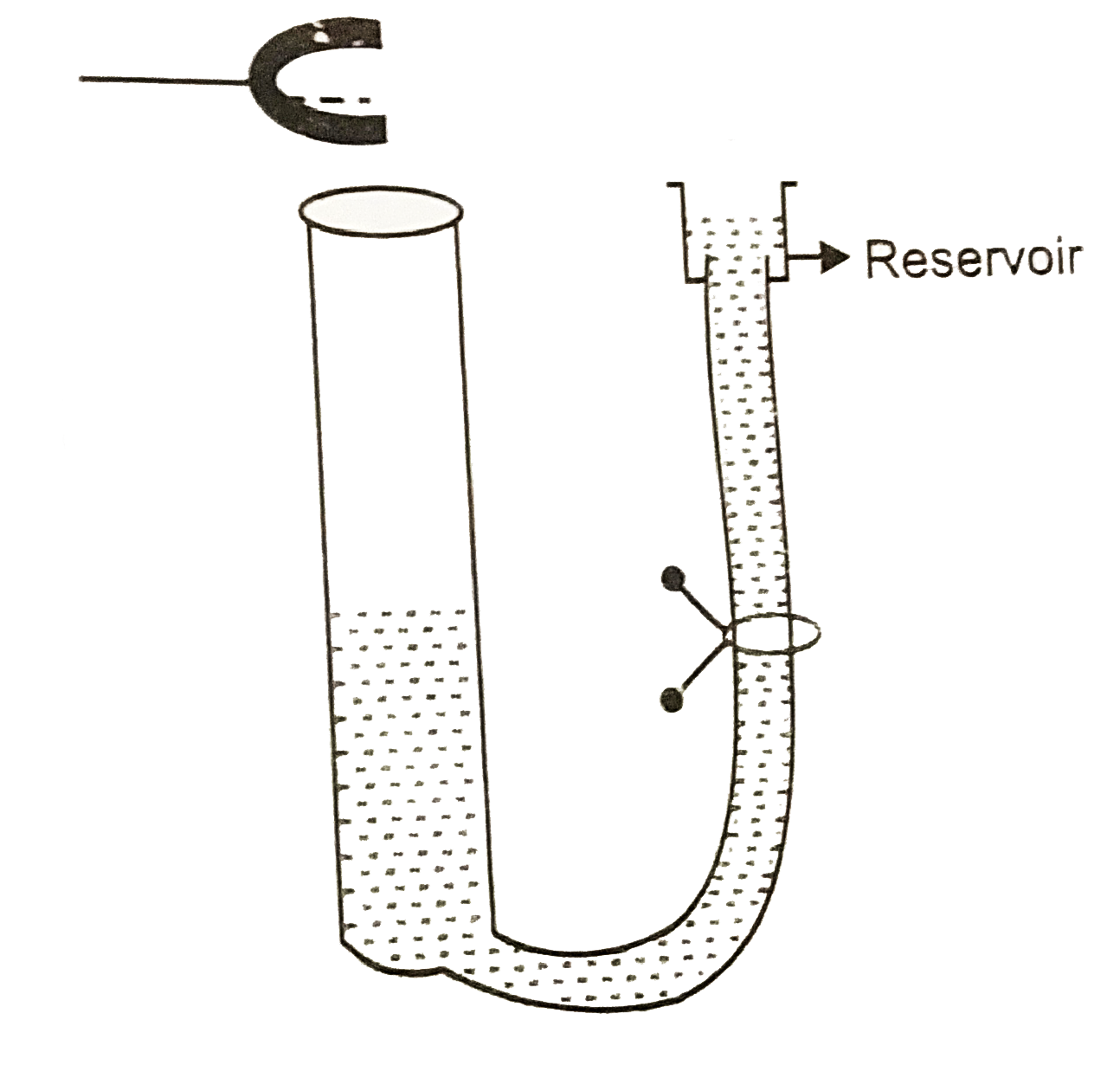
View SolutionShow that when a string fixed at its two ends vibrates in 1 loops, 2 loops , 3 loops and 4 loops , the frequencies are in the ration `1:2:3:4.`
View SolutionThe earth has a radius of 6400km. The inner core of 1000 km radius is solid. Outside it, there is a region from 1000 km to a radius of 3500km which is in molten state. Then again from 3500km to 6400 km, the earth is solid. Only longitudingal (P) waves can travel inside a liquid. Assume that the P wave has a speed of `8kms^(-1)` in solide parts and of `5kms^(-1)` in liquid parts of the earth. Calculate the time after which it will be recorded in a seismometer at a diametrically opposite point on earth if wave travels along diameter /
View Solution
Short Answer Questions questions and complete solutions for chapter OSCILLATIONS AND WAVES of PRADEEP PHYSICS (HINGLISH) of Class 11
All Exercises from PRADEEP Class 11 PHYSICS OSCILLATIONS AND WAVES
- Additional Exercises
- Advanced Problems For Competitions
- Assertion-Reason Type Questions
- conceptual problems
- CURIOSITY QUESTION
- Fill In The Blanks
- Higher Order Thinking Skills
- integer type question
- JEE mains adv..(multiple choice quection)
- Long Answer Questions
- Multiple Choice Question
- Multiple Choice Question-I
- Multiple Choice Question-II
- multiple choice Questions
- NCERT CHAPTER
- NCERT EXERCISES WITH SOLUTIONS
- PROBLEMS FOR PRACTICE
- SAMPLE PROBLEM
- Short Answer Questions
- SOLVED EXAMPLES
- Value Based Questions
- Very Short Answer Questions